PUBLIC FINANCIAL SUPPORT AND INBOUND OPEN INNOVATION IN DEVELOPING ECONOMIES: EVIDENCE FROM MOROCCAN FIRMS
DOI:
https://doi.org/10.2478/eoik-2025-0064Keywords:
Inbound Open Innovation, Public Financial Support, Absorption Capacity, Propensity Score Matching (PSM)Abstract
The objective of this study is to quantitatively examine the impact of
public financial support (PFS) on the adoption of inbound open inno-
vation (IOI). The study is based on data from the World Bank survey
of 1,096 Moroccan firms (WBES, 2020). Inbound open innovation
is measured by two indicators, namely the acquisition of external
knowledge and the use of licensed foreign technologies. Given the
nature of the data, we apply two complementary methods to control
for the potential endogeneity problem associated with access to pub-
lic funding: logistic regression and propensity score matching (PSM).
The results show that firms benefiting from public financial support
are more likely to adopt inbound open innovation (IOI), i.e., the ac-
quisition of external knowledge and the use of licensed foreign tech-
nologies. This result highlights the strategic role of public innovation
policy, particularly public financial support, in supporting innovation
in developing countries (DCs). Our study concludes that targeted fi-
nancing mechanisms can strengthen the absorptive capacity of com-
panies, particularly in contexts where private investment in research
and development (R&D) and technological knowledge remains lim-
ited. This can generate positive spin-offs not only for companies ben-
efiting from public financial support (PFS), but also for the economy
as a whole, by improving productivity, boosting competitiveness, and
helping to bridge the technology gap with advanced countries.
References
Acemoglu, D. (2002). Directed technical change. The review of economic studies, 69(4), 781-809.
http://dx.doi.org/10.1111/1467-937X.00226
Afcha Chàvez, S. M. (2011). Behavioural additionality in the context of regional innovation policy in Spain. Inno-
vation: Management, Policy and Practice, 13(1), 95–110. https://doi.org/10.5172/impp.2011.13.1.95
Ahn, J. M., Lee, W., & Mortara, L. (2020). Do government R&D subsidies stimulate collabora-
tion initiatives in private firms?. Technological Forecasting and Social Change, 151,
https://doi.org/10.1016/j.techfore.2019.119840
Almus, M., & Czarnitzki, D. (2003). The Effects of Public R&D Subsidies on Firms’ Innovation A c-
tivities: The Case of Eastern Germany. Journal of Business Economics Statistics, 21, 226- 236.
https://doi.org/10.1198/073500103288618918
Angrist, J. D., Imbens, G. W., & Rubin, D. B. (1996). Identification of causal effects using instrumental
variables. Journal of the American statistical Association, 91(434), 444-455. https://doi.org/10.
/01621459.1996.10476902
Antonelli, C. & Crespi, F. (2013). The “Matthew effect” in R&D public subsidies: The Italian evidence. Technolo-
gical Forecasting and Social Change, 80(8), 1523-1534. https://doi.org/10.1016/j.techfore.2013.03.008
Ardito, L., Natalicchio, A., Messeni Petruzzelli, A., & Garavelli, A. C. (2018). Organizing for continuous
technology acquisition: The role of R&D geographic dispersion. R&D Management, 48(2),
-176. https://doi.org/10.1111/radm.12270
Arora, A., A. Fosfuri, and T.Roende. 2013. Managing Licensing in a Market for Technology. Manage-
ment Science 59(5): 1092-1106. https://doi.org/10.1287/mnsc.1120.1628
Awate, S., Larsen, M. M., & Mudambi, R. (2015). Accessing vs sourcing knowledge: A comparative stu-
dy of R&D internationalization between emerging and advanced economy firms. Journal of
International Business Studies, 46, 63-86. https://doi.org/10.1057/jibs.2014.46
Bakracheva, M. (2025). Personality Predictors of Flourishing and Learning to Flourish. Internation-
al Journal of Cognitive Research in Science, Engineering and Education (IJCRSEE), 13(1),
–156. https://doi.org/10.23947/2334-8496-2025-13-1-141-156
Barajas, A., Huergo, E., & Moreno, L. (2021). The role of public loans in financing business R&D through
the economic cycle. Economia Politica, 38, 505-538. https://doi.org/10.1007/s40888-021-00225-9
Bianchi, M., & Lejarraga, J. (2016). Learning to license technology: the role of experience and
workforce’s skills in Spanish manufacturing firms. R&D Management, 46(S2), 691-705. https://
doi.org/10.1111/radm.12211
Bogers, M., Chesbrough, H., & Strand, R. (2020). Sustainable open innovation to address a grand
challenge: Lessons from Carlsberg and the Green Fiber Bottle. British Food Journal, 122(5),
–1517. https://doi.org/10.1108/BFJ-07-2019-0534
Cabaleiro-Cerviño, G., & Burcharth, A. (2020). Licensing agreements as signals of innovation: When do they
impact market value?. Technovation, 98, 102175. https://doi.org/10.1016/j.technovation.2020.102175
Cano-Kollmann, M., Hamilton III, R. D., & Mudambi, R. (2017). Public support for innovation and
the openness of firms’ innovation activities. Industrial and Corporate Change, 26(3), 421-442.
https://doi.org/10.1093/icc/dtw025
Cassiman, B., & Veugelers, R. (2006). In search of complementarity in innovation strategy: Internal
R&D and external knowledge acquisition. Management science, 52(1), 68-82. https://doi.
org/10.1287/mnsc.1050.0470
Crespi, G., Garone, L. F., Maffioli, A., & Melendez, M. (2015). Long-term productivity effects of public
support to innovation in Colombia. Emerging markets finance and trade, 51(1), 48-64. https://
doi.org/10.1080/1540496X.2015.998080
Chesbrough, H. W. (2003). Open innovation: The new imperative for creating and profiting fromtechnolo-
gy. Harvard Business School. https://www.sustanciainfinita.com/wp-content/uploads/2017/03/
LIBRO-Henry-Chesbrough-Open-Innovation.pdf
Hosni M. et al. / Economics - Innovative and Economics Research Journal, doi: 10.2478/eoik-2025-0064
Chesbrough, H. W. (2006), Open business models: How to thrive in the new innovation landscape, Boston: Har-
vard Business Press. https://www.academia.edu/5008637/Chesbrough_H_Open_Business_Models
Chesbrough, H. W., & Vanhaverbeke, W. (2018). Open innovation and Public Policy in the EU
with Implications for SMEs. In Researching open innovation in SMEs, 455-492. https://doi.
org/10.1142/9789813230972_0015
Cohen, W. M., & Levinthal, D. A. (1990). Absorptive capacity: A new perspective on learning and
innovation. Administrative science quarterly, 35(1), 128-152. https://doi.org/10.2307/2393553
Costa, J., & Moreira, A. C. (2022). Public policies, open innovation ecosystems and innovation per-
formance. Analysis of the impact of funding and regulations. Journal of Open Innovation: Tech-
nology, Market, and Complexity, 8(4), 210. https://doi.org/10.3390/joitmc8040210
Dewan, R., Jing, B., & Seidmann, A. (2003). Product customization and price competition on the in-
ternet. Management Science, 49(8), 1055–1070. https://doi.org/10.1287/mnsc.49.8.1055.16401
Dohse, D., Goel, R. K., & Nelson, M. A. (2019). What induces firms to license foreign technologies?
International survey evidence. Managerial and Decision Economics, 40(7), 799-814. https://
doi.org/10.1002/mde.3044
Edquist, C., 2001. The systems of innovation approach and innovation policy: an account of the state of the
art. In: Paper presented at the DRUID Conference, Aalborg, Denmark. https://citeseerx.ist.psu.
edu/document?repid=rep1&type=pdf&doi=a7f9e570864ee75dd3bcca9ca86885190a0d5134
Elhassan, T. (2025). Green technology innovation, green financing, and economic growth in G7 coun-
tries: Implications for environmental sustainability. Economics - innovative and economics re-
search journal, 13(1), 69–91. https://doi.org/10.2478/eoik-2025-0023
Elia, S., Munjal, S., & Scalera, V. G. (2020). Sourcing technological knowledge through foreign inward
licensing to boost the performance of Indian firms: The contingent effects of internal R&D
and business group affiliation. Management International Review, 60(5), 695-721. https://doi.
org/10.1007/s11575-020-00419-6
Felipe Berrutti & Carlos Bianchi (2019): Effects of public funding on firm innovation : transform-
ing or reinforcing a weak innovation pattern?, Economics of Innovation and NewTechnology.
https://doi.org/10.1080/10438599.2019.1636452
Greco, M., Grimaldi, M., & Cricelli, L. (2017). Hitting the nail on the head: Exploring the relationship
between public subsidies and open innovation efficiency. Technological Forecasting and Social
Change, 118, 213-225. https://doi.org/10.1016/j.techfore.2017.02.022
Haddoud, M. Y., Kock, N., Onjewu, A. K. E., Jafari-Sadeghi, V., & Jones, P. (2023). Technology, i n-
novation and SMEs’ export intensity: Evidence from Morocco. Technological Forecasting and
Social Change, 191, 122475. https://doi.org/10.1016/j.techfore.2023.122475
Heckman, J.J., Ichimura, H., Todd, P. : E (1997) : Matching as an econometric evaluation e s t i m a t o r :
Evidence from evaluating a job training programme. Rev. Econ. Stud. 64(4), 605–654. https://
doi.org/10.2307/2971735
Heckman, J.J., Robb, R. (1985): Alternative methods for evaluating the impact of interventions: An
overview. J. Econ. 30(2), 239–267. https://doi.org/10.1016/0304-4076(85)90139-3
Hewitt-Dundas, N., & Roper, S. (2018). Exploring market failures in open innovation. Int. Small Bus.
J. 36 (1), 23–40. https://doi.org/10.1177/0266242617696347
Hirano, K., imbens, G. w., & ridder, G. (2003). efficient estimation of average treatment effects using the esti-
mated propensity score. Econometrica, 71(4), 1161-1189. https://doi.org/10.1111/1468-0262.00442
Imbens, G.W., Lemieux, T. (2008): Regression discontinuity designs: a guide to practice. J Econ 142(2),
–635. https://doi.org/10.1016/j.jeconom.2007.05.001
Imbens, G. W. and Wooldridge, J. M. (2009) ‘Recent Developments in the Econometrics of Program
Evaluation’, Journal of Economic Literature, 47/1: 5–86. https://doi.org/10.1257/jel.47.1.5
Jesus, G.M.K., Jugend, D., 2023. How can open innovation contribute to circular economy adoption? Insights
from a literature review. Eur. J. Innov. Manag. 26 (1), 65–98. https://doi.org/10.1108/ejim-01-2021-0022
Public Financial Support and Inbound Open Innovation in Developing Economies: Evidence from Moroccan Firms
Jugend, D., Fiorini, P. D. C., Armellini, F., & Ferrari, A. G. (2020). Public support for innovation : A sys-
tematic review of the literature and implications for open innovation. Technological Forecasting
and Social Change, 156, 119985. https://doi.org/10.1016/j.techfore.2020.119985
Kang, K.N., Park, H., 2012. Influence of government R&D support and inter-firm collaborations on in-
novation in Korean biotechnology SMEs. Technovation 32 (1), 68–78. https://doi.org/10.1016/j.
technovation.2011.08.004
Laursen, K., & Salter, A. (2006). Open for innovation: the role of openness in explaining innovation
performance among UK manufacturing firms. Strategic management journal, 27(2), 131- 150.
https://doi.org/10.1002/smj.507
Leckel, A., Veilleux, S., & Dana, L. P. (2020). Local Open Innovation: A means for public policy to in-
crease collaboration for innovation in SMEs. Technological Forecasting and Social Change, 153,
https://doi.org/10.1016/j.techfore.2019.119891
Li-Ying, J., Wang, Y., Salomo, S., & Vanhaverbeke, W. (2013). Have Chinese firms learned from their
prior technology in-licensing? An analysis based on patent citations. Scientometrics, 95, 183-
https://doi.org/10.1007/s11192-012-0802-x
Li-Ying, J., & Wang, Y. (2015). Find them home or abroad? The relative contribution of international
technology in-licensing to “indigenous innovation” in China. Long Range Planning, 48(3), 123-
https://www.sciencedirect.com/science/article/abs/pii/S0024630114000211
Lopez, R. A. (2008). Foreign technology licensing, productivity, and spillovers. World Develop-
ment, 36(4), 560-574. https://doi.org/10.1016/j.worlddev.2007.04.016
Mardones, C., Zapata, A., (2019). Impact of public support on the innovation probability in Chilean firms.
Econ. Innov. New Technol. 28 (6), 569–589. https://doi.org/10.1080/10438599.2018.1546548
Mastilo, Z., Barić, F. & Puška, A. (2025). Challenges and Opportunities of Implementing Digital Pay-
ment Systems in Southeast European Countries. Journal of Central Banking Theory and Prac-
tice, 14(2), 5-28. https://doi.org/10.2478/jcbtp-2025-0011
Mazzucato, M., & Robinson, D.K. (2018). Co-creating and directing innovation ecosys-
tems? NASA’s changing approach to public-private partnerships in low-earth orbit. Technol.
Forecast. Soc. Change 136, 166–177. https://doi.org/10.1016/j.techfore.2017.03.034
Moreira, S., Klueter, T. M., & Tasselli, S. (2020). Competition, technology licensing-in, and innova-
tion. Organization Science, 31(4), 1012-1036. https://doi.org/10.1287/orsc.2019.1337
Ouakil, H., Lakhal, T., El Ouazzani, H., & Moustabchir, A. (2024). Understanding the Role of Income
in Personal Happiness: A Comprehensive PSM Analysis in the United States. The Pakistan
Development Review, 399-416. https://doi.org/10.30541/v63i3pp.399-416
Perri, A., Scalera, V. G., & Mudambi, R. (2017). What are the most promising conduits for foreign
knowledge inflows? Innovation networks in the Chinese pharmaceutical industry. Industrial
and Corporate Change, 26(2), 333-355. https://doi.org/10.1093/icc/dtx004
Radicic, D. (2019). Effectiveness of public procurement of innovation versus supply-side innovation
measures in manufacturing and service sectors. Science and Public Policy, 46(5), 732-746.
https://doi.org/10.1093/scipol/scz021
Radicic, D., Pugh, G., & Douglas, D. (2020). Promoting cooperation in innovation ecosystems: e v i-
dence from European traditional manufacturing SMEs. Small Business Economics, 54(1), 257-
https://doi.org/10.1007/s11187-018-0088-3
Rajapathirana, R. J., & Hui, Y. (2018). Relationship between innovation capability, innovation type, and
firm performance. Journal of Innovation & Knowledge, 3(1), 44-55. https://doi.org/10.1016/j.
jik.2017.06.002
Ranga, M., & Etzkowitz, H. (2013). Triple helix systems: an analytical framework for innovation policy
and practice in the knowledge society. Ind. High. Educ. 27 (4), 237–262. https://doi.org/10.5367/
ihe.2013.0165
Hosni M. et al. / Economics - Innovative and Economics Research Journal, doi: 10.2478/eoik-2025-0064
Rizov, M., Vecchi, M., & Domenech, J. (2022). Going online: Forecasting the impact of websites on
productivity and market structure. Technological Forecasting and Social Change,184, 121959.
https://doi.org/10.1016/j.techfore.2022.121959
Rosenbaum, P. R., & Rubin, D. B. (1983). The central role of the propensity score in observational stu-
dies for causal effects. Biometrika, 70(1), 41-55. https://doi.org/10.1093/biomet/70.1.41
Rosário, C., Varum, C., & Botelho, A. (2022). Impact of public support for innovation on company perfor-
mance: review and meta-analysis. Sustainability, 14(8), 4731. https://doi.org/10.3390/su14084731
Rubin, D.B. (1974): Estimating causal efects of treatments in randomized and nonrandomized studies.
J. Educ. Psychol. 66(5), 688. https://doi.org/10.1037/h0037350
Sabando-Vera, D., Yonfa-Medranda, M., Montalván-Burbano, N., Albors-Garrigos, J., & Parrales-Guer-
rero, K. (2022). Worldwide research on open innovation in SMEs. Journal of Open Innovation:
Technology, Market, and Complexity, 8(1), 20. https://doi.org/10.3390/joitmc8010020
Schumpeter, J.A. (1934), The Theory of Economic Development, Harvard University Press, Cam-
bridge, MA. https://doi.org/10.4324/9781003146766
Teece, D. J. (1992). Competition, cooperation, and innovation: Organizational arrangements for regimes
of rapid technological progress. Journal of economic behavior & organization, 18(1), 1-25.
https://doi.org/10.1016/0167-2681(92)90050-L
Topić – Pavković, B. (2024). Challenges to Global Monetary and Financial Stability. Collection of
papers new economy 2(1), 31-45. https://doi.org/10.61432/CPNE0201031t
Trifunović, I., Spalević, Žaklina, Zdravković, S., Dimić, G., Ilić, M., & Dubljanin, D. (2025). Behavior-
al Cultural Intelligence, Legal System, Cybersecurity and Cultural Heritage as Determinants of
the Choice of Foreign Tourist Destinations. International Journal of Cognitive Research in Sci-
ence, Engineering and Education (IJCRSEE), 13(1), 207–215. https://doi.org/10.23947/2334-
-2025-13-1-207-215
Tsai, K.-H. and Wang, J.-C. (2008) External technology acquisition and firm performance: A longitudinal
study. Journal of Business Venturing, 23, 91-112. https://doi.org/10.1016/j.jbusvent.2005.07.002
Tsai, K. H., & Wang, J. C. (2009). External technology sourcing and innovation performance in LMT
sectors: An analysis based on the Taiwanese Technological Innovation Survey. Research Poli-
cy, 38(3), 518-526. https://doi.org/10.1016/j.respol.2008.10.007
Wang, Y., & Li‐Ying, J. (2015). Licensing foreign technology and the moderating role of local R&D col-
laboration: Extending the relational view. Journal of Product Innovation Management, 32(6),
-1013. https://doi.org/10.1111/jpim.12246
WBES. 2020. World Bank Enterprise Surveys, www.enterprisesurveys.org
Wooldridge, J.M., 2002. Econometric Analysis of Cross Section and Panel Data. MIT Press, Cambridge
MA. https://doi.org/10.1007/s00712-003-0589-6
Zaghdoud, O. (2025). Environmental Fiscal Policies and the Double Dividend Hypothesis: A Dynamic
CGE-OLG Analysis in Tunisia. Economics - Innovative and economics research journal, 13(2),
–53. https://doi.org/10.2478/eoik-2025-0029
Zhang, W., & Xiaofeng, L. I. U. (2023). The impact of internet on innovation of manufactu-
ring export enterprises: Internal mechanism and micro evidence. Journal of Innovation &
Knowledge, 8(3), 100377. https://doi.org/10.1016/j.jik.2023.100377
Downloads
Published
How to Cite
Issue
Section
License
Copyright (c) 2025 ECONOMICS - INNOVATIVE AND ECONOMICS RESEARCH JOURNAL

This work is licensed under a Creative Commons Attribution-NonCommercial-NoDerivatives 4.0 International License.























